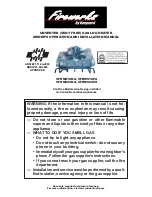
IGNITION FOR ELECTRONIC
MODELS (…kWE)
1. Open the gas cylinder.
2. Turn the fan’s switch upon the position II (see
Þ
g.6). The fan
start working and after a short pre-ventilation the
ß
ame turn on.
3. If the heater stops some seconds after the
ß
ame is lit,
please invert the plug after pressing the RESET push-button.
4. If the generator stops, on light on the RESET button. Wait about
a minute and then release the generator operating on the RESET
button.
IGNITION FOR dual voltage
MANUAL MODELS, (…KWDV)
1. Check the position of the switch (230-115). If it requires modi-
fying, unscrew the 2 screws securing the cap (see
Þ
g. 9) and
turn the switch to the voltage value being used.
2. Proceed as in the previous paragraph (igni-
tion for manual ignition types, …KW).
STOPPING
• Turn off the cylinder.
• Let the fan run for about 60 seconds for cooling.
• Turn the switch to position 0.
USE IN ENVIRONMENTS WITH
NO PERMANENT PRESENCE
OF PEOPLE OR ANIMALS
• Signs must be displayed prohibiting people from stopping per-
manently in that room.
• The generators must only be used to dry rooms, provided that
there is a guaranteed quantity of air exchange necessary for
combustion.
• The necessary quantity of air is when the volume of the room
(in m
3
) is at least 10 times the nominal calori
Þ
c power (in kW) of
all the machines used in that room.
• A normal air circulation through doors and windows must be
assured.
USE IN ENVIRONMENTS WITH
PERMANENT PRESENCE OF
PEOPLE OR ANIMALS
•
The generators can be used in well-ventilated rooms and when
the percentage of polluting substances in the air does not exceed
levels of danger for health.
•
A good ventilation is guaranteed when the room’s volume (in
m
3
) is at least 30 times the nominal calori
Þ
c power (in kW) of
all the machines used in that room and when an air circulation
through doors, windows or permanent openings can be guar-
anteed, whose size (in m
2
) is at least 0,003 times the nominal
calori
Þ
c power (in kW) of all the machines used in that room.
•
The apparatus should not be used for continuous heating of
stables and farms.
SUMMER VENTILATION
The heater can be used also like ventilator. Turn off the gas and
disconnect the
ß
exible gas hose from the gas cylinder. Connect
the electrical plug to a suitable socket and set the switch in the
position I.
CLEANING AND
MAINTENANCE
Periodically and before putting the appliance away after use,
clean it.
• Before starting any kind of maintenance and repairing opera-
tions, it is absolutely necessary to unplug the apparatus.
• Close the cylinder tap.
• Maintenance concerns solely cleaning the burner outlets, the
eventual replacement of the calibrated nozzle and the replace-
ment of the
ß
exible hose.
• Clean the burner periodically if it is used in a dusty place.
• When the appliance is run by radio-control, check wear of the
gas pipe and power cable; if you have any doubts about their
condition, call in the servicing department.
• After each servicing operation a soundness test shall be car-
ried out over the gas circuit by aid of soap water.
”LPG” HOT AIR GENERATOR
TROUBLESHOOTING
Problem
Cause
Remedy
The motor does not turn on
1.Faulty mains cable
2.Faulty fan
3.Faulty switch
1.Replace or repair
2.Replace or repair
3.Replace or repair
The
ß
ame does not ignite
1.Excessive distance between electrode and burner
2.Lack of gas
3.Faulty gas valve
4. Safety valves tripped
1.Adjust distance
2.Replace cylinder
3.Specialized work needed
4.Press the push-button to reset the safety valve
The
ß
ame goes out after a
few seconds of ignition
1.Excessive distance between the temperature sensor
and the burner
2.Gas button released after a too short time
3.Faulty safety chain
4.Appliance is overheated.
1.Adjust distance
2.Keep the button pressed a little longer (max 20”)
3.Specialized work needed
4.Safety thermostat must cool. Wait 5 minutes and
re-start.
Flame goes out during
operation.
1. insuf
Þ
cient gas supplied
2. appliance overheating excessively
1. replace the cylinder
2. insuf
Þ
cient air supplied
The
ß
ame has a yellow
luminous outline
1.Air fault in the burner
2.Excess of gas in the burner
1.Clean air inlet
2.Adjust pressure and/or replace nozzle
4
GB
Fig. 13





































